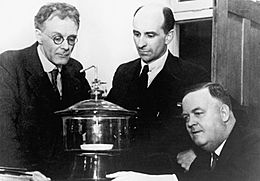David Rivett facts for kids
Sir Albert Cherbury David Rivett (born December 4, 1885 – died April 1, 1961) was an important Australian scientist. He was a talented chemist and helped lead scientific research in Australia. He is remembered for his work in chemistry and for helping to create the CSIRO, a major science organization.
Quick facts for kids
David Rivett
|
|
|---|---|

George Julius, David Rivett and Arnold Richardson
|
|
| Born |
Albert Cherbury David Rivett
4 December 1885 |
| Died | 1 April 1961 (aged 75) |
| Alma mater | University of Melbourne |
| Awards | Rhodes Scholarship Fellow of the Royal Society (1941) James Cook Medal (1953) |
| Scientific career | |
| Institutions | University of Oxford |
Contents
Early Life and Education
Albert Rivett was born in a place called Port Esperance in Tasmania, Australia. His father, Albert Rivett, was a pastor who believed strongly in peace.
Young Albert went to Wesley College, Melbourne and then studied at the University of Melbourne. He earned a Bachelor of Science degree in 1906. Later, in 1913, he received a Doctor of Science degree.
He was also chosen as a Rhodes Scholar. This special scholarship allowed him to study at Lincoln College, Oxford in England. There, he did important research and earned more degrees with top honors.
A Career in Chemistry
In 1910, Albert Rivett spent six months working at the Nobel Institute in Stockholm, Sweden. He worked with a famous scientist named Svante Arrhenius.
After his time in Sweden, he returned to Australia in 1911. He became a chemistry lecturer at the University of Melbourne. That same year, he married Stella Deakin. Stella was also a research chemist and the daughter of Alfred Deakin, who had been a Prime Minister of Australia.
Organizing Science Events
In 1914, Rivett helped organize a big science meeting in Australia. It was for the British Association for the Advancement of Science. This was the first time this important meeting was held outside the United Kingdom.
Contributions During Wartime
During World War I, from 1915 to 1919, Rivett was involved in important work. From 1917, he helped produce a pure chemical called ammonium nitrate. This chemical was used to make materials for industrial purposes. His experience taught him how important basic scientific research is for practical uses in industries.
Leading Chemistry at University
In 1921, he became an Associate Professor at the University of Melbourne. By 1924, he became a full Professor of Chemistry, taking over from his former colleague, Professor David Orme Masson.
Shaping Australian Science
Albert Rivett played a huge role in shaping science in Australia. From 1927 to 1946, he was a key leader for the 'Council for Scientific and Industrial Research' (CSIR). This organization was very important for scientific development in Australia.
The CSIR later changed its name to the Commonwealth Scientific and Industrial Research Organisation (CSIRO). Rivett was the Chairman of the CSIRO from 1946 to 1949.
Awards and Recognition
For his great contributions, Albert Rivett received many honors:
- In 1935, he was made a Knight Commander of the Order of St Michael and St George (KCMG). This meant he was given the title "Sir."
- In 1941, he became a Fellow of the Royal Society of London. This is a very high honor for scientists.
- In 1954, he was a founding fellow of the Australian Academy of Science.
- He also served as president of the Australian and New Zealand Association for the Advancement of Science from 1937 to 1939.
Sir Albert Rivett passed away in Sydney in 1961. A suburb in the Australian Capital Territory called Rivett is named after him.
Family Life
Sir David Rivett and his wife, Lady Stella Rivett, had two children. Their son, Rohan Deakin Rivett, became a journalist. Their other son, Dr Kenneth Deakin Rivett, became an academic economist.

